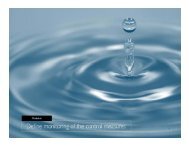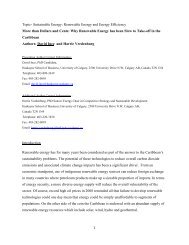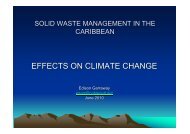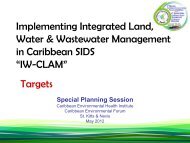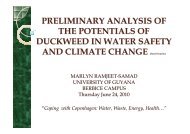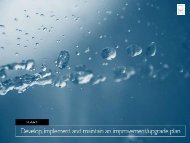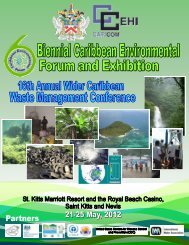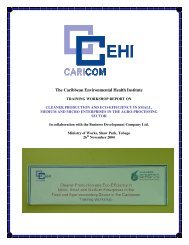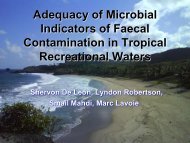A programme for Promoting Rainwater Harvesting in the Caribbean
A programme for Promoting Rainwater Harvesting in the Caribbean
A programme for Promoting Rainwater Harvesting in the Caribbean
Create successful ePaper yourself
Turn your PDF publications into a flip-book with our unique Google optimized e-Paper software.
<strong>Caribbean</strong> <strong>Ra<strong>in</strong>water</strong> <strong>Harvest<strong>in</strong>g</strong> ProgrammeGrenadaMa<strong>in</strong>land Grenada’s water supply is drawn almost exclusively from surface stream sourceslocated at relatively high elevations so that <strong>the</strong> distribution network is primarily gravity-fed.The estimated water production ranges between 27,300 m 3 /day (6 MGD) and 31,800 m 3 /day(7 MGD) dur<strong>in</strong>g <strong>the</strong> dry and wet seasons respectively. The National Water and SewerageCorporation (NAWASA) claims up to 90% coverage of <strong>the</strong>ir distribution network withreliability <strong>in</strong> service provision that ranges between 85 and 90%. Communities <strong>in</strong> <strong>the</strong> extremesouth and north of <strong>the</strong> island tend to be more water-stressed given <strong>the</strong>ir relative location at<strong>the</strong> distal ends of <strong>the</strong> distribution networks, a problem that can be particularly acute dur<strong>in</strong>g<strong>the</strong> dry season. Demands from tourism and o<strong>the</strong>r commercial sectors and urbanization areplac<strong>in</strong>g pressures on <strong>the</strong> exist<strong>in</strong>g production po<strong>in</strong>ts. In 1998 <strong>the</strong> Government of Grenada (GoG)procured a 1,818 m 3 /day (400,000 US GPD) desal<strong>in</strong>ation plant to assist <strong>in</strong> augmentation ofwater supply to <strong>the</strong> sou<strong>the</strong>rn communities, however, <strong>in</strong>adequate supply from production wellsdelayed <strong>the</strong> completion of project. NAWASA is also consider<strong>in</strong>g deep-well abstraction <strong>for</strong>supply augmentation <strong>for</strong> ma<strong>in</strong>land Grenada (A. Neptune pers. comm. 2006)On <strong>the</strong> sister islands of Carriacou and Petit Mart<strong>in</strong>ique water is drawn almost exclusively from<strong>in</strong>dividual or communal RWH systems as <strong>the</strong>se islands are very arid and have virtually noperennial streams. There is 1 borehole from which groundwater is abstracted to serve <strong>the</strong> smalldowntown core of Hillsborough <strong>in</strong> Carriacou. <strong>Ra<strong>in</strong>water</strong> also f<strong>in</strong>ds uses <strong>in</strong> o<strong>the</strong>r sectors such asagriculture, construction and tourism. In 1998 <strong>the</strong> Government of Grenada <strong>in</strong>vested <strong>in</strong>desal<strong>in</strong>ation plants <strong>for</strong> both Carriacou (100,000 US GPD output capacity) and PetitMart<strong>in</strong>ique (30,000 GPD output capacity). The <strong>for</strong>mer is plagued with regular mechanicalfailures, while <strong>the</strong> latter, s<strong>in</strong>ce <strong>the</strong> passage of hurricane Ivan has been non-functional. A fewhotels and resorts (e.g. <strong>in</strong> Culligen) have small desal<strong>in</strong>ation plants to augment <strong>the</strong>ir watersupplies (CEHI, 2006).RWH is practiced to a small degree on ma<strong>in</strong>land Grenada but more so by households <strong>in</strong>communities particularly <strong>in</strong> <strong>the</strong> south of <strong>the</strong> island where <strong>the</strong>re are serious supply problems. Ingeneral, <strong>the</strong> practice has become less common as NAWASA’s distribution has expanded toservice almost all communities on <strong>the</strong> island. By contrast, RWH is of paramount importance <strong>in</strong>Carriacou and Petit Mart<strong>in</strong>ique where communal and private systems supply almost 100% ofdemand. There are no specific policies or legislative provisions to support RWH <strong>in</strong> Grenada.JamaicaJamaica exploits over 400 ground and surface water sources where <strong>the</strong> estimated dailyproduction is 913 MCM (million cubic metres) per day. More than 70% of <strong>the</strong> country’s watercomes from ground water sources (NWC, 2003). The public water supply system operated by<strong>the</strong> National Water Commission presently services 72% of <strong>the</strong> population. While Jamaica hassufficient water to meet all demands, <strong>the</strong> resources are unevenly distributed <strong>in</strong> both time andlocation. The present shortfall is estimated at 400 MCM/yr (GoJ, 1999). Roughly 30% of waterabstracted goes to domestic purpose while 70% goes <strong>in</strong>to non-domestic purpose which <strong>in</strong>cludesagriculture.The large landmass comb<strong>in</strong>ed with <strong>the</strong> topography, hydrologic and economicconsiderations present challenges to realization of 100% coverage, and isolated communitiesneed to rely on small water supply systems whe<strong>the</strong>r from catchment tanks, truck deliveries or14





